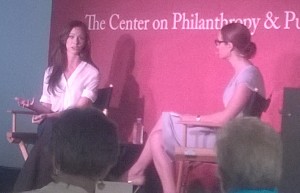 “Global Health Corps pairs intelligent and passionate fellows with organizations that require new thinking and innovative solutions. We provide these young leaders with the tools to remain connected after their fellowship year finishes, deepening their ability to enact change through heightened skills and strong partnerships. We currently place fellows in Burundi, Malawi, Rwanda, Uganda, the United States, and Zambia.” Today, at the USC Center of Philanthropy and Public Policy’s Conversation on Philanthropy and Global Health, I had the opportunity to hear Barbara Bush speak about the organization that she co-founded. The conversation was moderated by Cara Esposito, Executive Director of the Leonetti/O’Connell Family Foundation.
“Global Health Corps pairs intelligent and passionate fellows with organizations that require new thinking and innovative solutions. We provide these young leaders with the tools to remain connected after their fellowship year finishes, deepening their ability to enact change through heightened skills and strong partnerships. We currently place fellows in Burundi, Malawi, Rwanda, Uganda, the United States, and Zambia.” Today, at the USC Center of Philanthropy and Public Policy’s Conversation on Philanthropy and Global Health, I had the opportunity to hear Barbara Bush speak about the organization that she co-founded. The conversation was moderated by Cara Esposito, Executive Director of the Leonetti/O’Connell Family Foundation.
One topic was intergenerational philanthropy and both Barbara and Cara are models of this. Coincidentally I have had connections with both speakers’ parents and grandparents. Points of Light and Business Strengthening America with the former and today’s convener (USC CPPP) and Disney with the latter. A sense of service being passed down through the generations. In fact Barbara became involved with the global health issue on a trip with her parents to Africa for PEPFAR (U.S. President’s Emergency Plan for AIDS Relief) . She was 20 years old and saw firsthand the devastation that AIDS was taking on the people of Africa and how targeted programs can help. The trip so influenced her that she changed her major from architecture to global health when she returned. Right out of college she took a job at the Red Cross Children’s Hospital in Capetown, South Africa.
Global Health Corps was created from a challenge to youth at a conference. Global health, its many facets, is a daunting issue to tackle. A group from the conference met and wondered if they could find an organization that used something similar to the Teach for America model but in the health arena. Not finding one, they wrote a business plan and created an organization themselves. Today, Barbara is the CEO.
GHC finds people who are under 30 to work for them for a year as a fellow. They have 52 partners that they work with who are great organizations doing service delivery. The fellows are imbedded in the organizations, they ask the right questions, identify the gaps and bring the right people together to address them. This year they had 128 positions and 11,000 applicants. They do want to scale, but maintaining the quality is of paramount importance. The cost of a fellow is $25,000 for the year. This covers all training, travel expenses, living expenses, placement costs, etc. Barbara’s dad gave a “fellowship” to her mom as a Christmas present last year.
The goal is that the fellows will not only affect the quality and delivery of health care during their year, but that they will influence the sector once they leave the fellowship. Building on this, a question came up regarding the development of the new UN Sustainable Development Goals. Barbara said that they have been part of the conversation and feels that their young voices need to be heard as many of her alumni will be responsible for implementing the new goals. Barbara’s compassion, smarts and drive are infectious and the conversation ended with her receiving a standing ovation. www.ghcorps.org www.cppp.usc.edu
